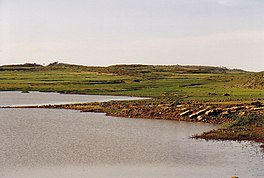Addi Amharay: Difference between revisions
Appearance
Content deleted Content added
Rastakwere (talk | contribs) page created |
Rastakwere (talk | contribs) →Addi Amharay: new section |
||
| Line 49: | Line 49: | ||
== References == |
== References == |
||
{{reflist}} |
{{reflist}} |
||
== Addi Amharay == |
|||
{{AFC submission|||ts=20190913112311|u=Rastakwere|ns=118}} |
|||
Revision as of 11:23, 13 September 2019
This article, Addi Amharay, has recently been created via the Articles for creation process. Please check to see if the reviewer has accidentally left this template after accepting the draft and take appropriate action as necessary.
Reviewer tools: Inform author |
| Addi Amharay | |
|---|---|
 | |
| Coordinates | 13°24′18″N 39°34′24″E / 13.40500132°N 39.5733461°E |
| Type | Freshwater artificial lake |
| Basin countries | Ethiopia |
| Surface area | 1.3 km2 (0.50 sq mi) |
| Water volume | 0.957×106 m3 (776 acre⋅ft) |
| Surface elevation | 2,320 m (7,610 ft) |
| Islands | 0 |
| Settlements | Kwiha |
Addi Amharay is a reservoir located in the Inderta woreda of the Tigray Region in Ethiopia. The earthen dam that holds the reservoir was built in 1997 by SAERT.[1]
Dam characteristics
- Dam height: 14.7 metres
- Dam crest length: 128 metres
- Spillway width: 17 metres
Capacity
- Original capacity: 957000 m³
- Dead storage: 175000 m³
- Reservoir area: 31.50 ha
In 2001, the life expectancy of the reservoir (the duration before it is filled with sediment) was estimated at 33 years.[1]
Irrigation
- Designed irrigated area: 60 ha
- Actual irrigated area in 2001: 5 ha
Environment
The catchment of the reservoir is 4.92 km² large, with a perimeter of 9.62 km and a length of 3560 metres. The reservoir suffers from rapid siltation.[2] The lithology of the catchment is Antalo Limestone and Agula shale.[1] Part of the water that could be used for irrigation is lost through seepage; the positive side-effect is that this contributes to groundwater recharge.[3]
References
- ^ a b c De Wit, Joke (2003). Stuwmeren in Tigray (Noord-Ethiopië): kenmerken, sedimentatie en sediment-bronnen. Unpub. M.Sc. thesis. Department of Geography, K.U.Leuven.
- ^ Nigussie Haregeweyn, and colleagues (2006). "Reservoirs in Tigray: characteristics and sediment deposition problems". Land Degradation and Development. 17: 211–230.
- ^ Nigussie Haregeweyn, and colleagues (2008). "Sediment yield variability in Northern Ethiopia: A quantitative analysis of its controlling factors". Catena. 75: 65–76.
Addi Amharay
This article, Addi Amharay, has recently been created via the Articles for creation process. Please check to see if the reviewer has accidentally left this template after accepting the draft and take appropriate action as necessary.
Reviewer tools: Inform author |

